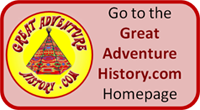|
Time Warner’s acquisition of the Six Flags parks in the early 1990’s
brought with it an array of innovative attractions and more coherent
theming throughout Great Adventure. Following in the spirit of new
attractions such as The Right Stuff Mach 1 Adventure and the rise of the
themed areas such as Adventure Rivers and the Old Country, Skull
Mountain was a roller coaster which focused on giving guests a unique
thrill experience that went beyond the ride-itself.
Concept art
showed that Skull Mountain was going to be an enclosed attraction where
themed elements would be used to tell the story of failed explorers who
tried navigating what seemed to be a tribal, haunted mountain. Riders
would assume the role of new explorers hoping to successfully tour the
caves.
The signature Skull that rests atop
the mountain was depicted as an elegant waterfall that flowed from the
eyes and mouth down across the many valleys of the structure into a pool
at its base.
|



